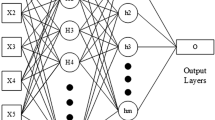Abstract
In this paper, a technique for selecting individual methods in a combined time series forecasting model is described. A neural network at the input of which a vector of time series metrics is proposed. The metrics corresponds to significant characteristics of the time series. The values of the metrics are easily computed. The neural network calculates the estimated prediction error for each model from the base set of the combined model. The proposed selection method is most effective for short time series and when the base set contains a lot of complex prediction methods. The developed system was tested on the time series from the CIF 2015-2016 competitions. According to the result of the experiment, the application of the developed system allowed to reduce the average forecast error from 13 to 9 percent.
Access this chapter
Tax calculation will be finalised at checkout
Purchases are for personal use only
Similar content being viewed by others
References
Tarasov, V.B.: From multi-agent systems to intellectual organizations: philosophy, psychology, informatics. Editorial, Moscow (2002)
Yarushkina, N.G.: Fuzzy hybrid systems. Theory and practice. Fizmatlit, Moscow (2007)
Gavrilov A.V.: Hybrid Intelligent Systems. NSTU, Novosibirsk (2003)
Kolesnikov, A.V., Kirikov, I.A., Listopad, S.V., Rumovskaya, S.B., Domanicky, A.A.: Solution of complex traveling salesman tasks using the methods of functional hybrid intelligent systems. Institute of Informatics Problems of the Russian Academy of Sciences, Moskow (2011)
Lukashin, Y.P.: Adaptive methods of short-term forecasting of time series. Finansy i statistika, Moscow (2003)
Novák, V.: Mining information from time series in the form of sentences of natural language. Int. J. Approximate Reasoning 78, 192–209 (2016)
Perfilieva, I.: Fuzzy transforms: theory and applications. Fuzzy Sets Syst. 157(8), 993–1023 (2006)
Abayomi-Alli, A., Odusami, M.O., Misra, S., Ibeh, G.F.: Long short-term memory model for time series prediction and forecast of solar radiation and other weather parameters. In: 2019 19th International Conference on Computational Science and Its Applications (ICCSA), pp. 82–92. IEEE (2019)
Kobzar, A.I.: Applied Mathematical Statistics. Fizmatlit, Moscow (2006)
Afanasyev, V.N., Yuzbashev, M.M.: Time series analysis and forecasting. Finansy i statistika Moscow (2001)
Ge, P., Wang, J., Ren, P., Gao, H., Luo, Y.: A new improved forecasting method integrated fuzzy time series with the exponential smoothing method. Int. J. Environ. Pollut. 51(3–4), 206–221 (2013)
CIF. http://irafm.osu.cz/cif/main.php. Accessed 22 June 2020
Afanasieva, T., Yarushkina, N., Zavarzin, D., Guskov, G., Romanov, A.: Time series forecasting using combination of exponential models and fuzzy techniques. In: Abraham, A., Kovalev, S., Tarassov, V., Snášel, V. (eds.) Proceedings of the First International Scientific Conference “Intelligent Information Technologies for Industry” (IITI’16). AISC, vol. 450, pp. 41–50. Springer, Cham (2016). https://doi.org/10.1007/978-3-319-33609-1_4
Pedrycz, W., Chen, S.: Time series analysis, modeling and applications: a computational intelligence perspective (2013). https://doi.org/10.1007/978-3-642-33439-9
Yarushkina, N., Andreev, I., Moshkin, V., Moshkina, I.: Integration of fuzzy OWL ontologies and fuzzy time series in the determination of faulty technical units. In: Misra, S., et al. (eds.) ICCSA 2019. LNCS, vol. 11619, pp. 545–555. Springer, Cham (2019). https://doi.org/10.1007/978-3-030-24289-3_40
Rybina, G.V.: Modern expert systems: trends towards integration and hybridization, devices and systems. Handling Control Diagnostics 8, 18–21 (2001)
Yarushev S., Averkin A. Time series analysis based on modular architectures of neural networks. In: Procedia Computer Science, 8th Annual International Conference on Biologically Inspired Cognitive Architectures, BICA 2017 (8th Annual Meeting of the BICA Society), pp. 562–567 (2018)
Timina, I., Egov, E., Romanov, A.: Fuzzy models in forecasting time series of project activity metrics. Paper presented at the Journal of Physics: Conference Series, vol. 1096 (2018)
Abayomi-Alli, A., Abayomi-Alli, O., Vipperman, J., Odusami, M., Misra, S.: Multi-class classification of impulse and non-impulse sounds using deep convolutional neural network (DCNN). In: Misra, S., et al. (eds.) ICCSA 2019. LNCS, vol. 11623, pp. 359–371. Springer, Cham (2019)
Acknowledgments
This work was supported by the Russian Foundation for Basic Research. Projects No. 18-47-730035, No. 19-07-00999 and 18-47-732007.
Author information
Authors and Affiliations
Corresponding author
Editor information
Editors and Affiliations
Rights and permissions
Copyright information
© 2020 Springer Nature Switzerland AG
About this paper
Cite this paper
Yashin, D., Moshkina, I., Moshkin, V. (2020). An Approach to the Selection of a Time Series Analysis Method Using a Neural Network. In: Gervasi, O., et al. Computational Science and Its Applications – ICCSA 2020. ICCSA 2020. Lecture Notes in Computer Science(), vol 12249. Springer, Cham. https://doi.org/10.1007/978-3-030-58799-4_50
Download citation
DOI: https://doi.org/10.1007/978-3-030-58799-4_50
Published:
Publisher Name: Springer, Cham
Print ISBN: 978-3-030-58798-7
Online ISBN: 978-3-030-58799-4
eBook Packages: Computer ScienceComputer Science (R0)




